Instructions for Side by Side Printing
- Print the notecards
- Fold each page in half along the solid vertical line
- Cut out the notecards by cutting along each horizontal dotted line
- Optional: Glue, tape or staple the ends of each notecard together
Exam 3, Chapter 7
front 1 THE TERMINOLOGY OF MICROBIAL CONTROL
| back 1 Techniques used in surgery to prevent microbial contamination from the instruments, operating personnel, and the patient. |
front 2 THE TERMINOLOGY OF MICROBIAL CONTROL
| back 2 The destruction or removal of all microbial life, including endospores. |
front 3 THE TERMINOLOGY OF MICROBIAL CONTROL
| back 3 By using filtration. |
front 4 THE TERMINOLOGY OF MICROBIAL CONTROL
| back 4 Is a sterilizing agent. |
front 5 THE TERMINOLOGY OF MICROBIAL CONTROL
| back 5 The process of treating canned goods aimed at destroying the endospores of Clostridium botulinum (a kind of food poisoning). |
front 6 THE TERMINOLOGY OF MICROBIAL CONTROL
| back 6 Clostridium botulinum produces a deadly toxin. More-resistant endospores of thermophilic (heat-loving) bacteria are capable of causing food spoilage but not human disease, and they will not germinate and grow at normal food storage temperatures. |
front 7 THE TERMINOLOGY OF MICROBIAL CONTROL
| back 7 Any treatment used on inanimate objects to kill or inhibit the growth of microorganisms; removing pathogens. |
front 8 THE TERMINOLOGY OF MICROBIAL CONTROL
| back 8 A chemical method for disinfection of the skin and mucous membranes; removing pathogens from living tissues. |
front 9 THE TERMINOLOGY OF MICROBIAL CONTROL
| back 9 Is the chemical used to perform the antisepsis technique. |
front 10 THE TERMINOLOGY OF MICROBIAL CONTROL
| back 10 The presence of a toxin or pathogenic organism in blood and tissue; refers to microbial contamination. |
front 11 THE TERMINOLOGY OF MICROBIAL CONTROL
| back 11 The absence of contamination by unwanted organisms. |
front 12 THE TERMINOLOGY OF MICROBIAL CONTROL
| back 12 The mechanical removal of microorganisms in an area or injection site, rather than killing them; also called degermation. |
front 13 THE TERMINOLOGY OF MICROBIAL CONTROL
| back 13 The removal of microorganisms from eating utensils and food preparation areas. |
front 14 Biocide, or Germicide | back 14 A substance capable of killing microorganisms (except endospores). |
front 15 THE TERMINOLOGY OF MICROBIAL CONTROL
| back 15 Names of treatments that cause the outright death of microbes; meaning kill. |
front 16 Bacteriostasis | back 16 A treatment capable of inhibiting bacterial growth. |
front 17 EFFECTIVENESS OF TREATMENT
| back 17 1. The number of microbes.
|
front 18 ACTION OF MICROBIAL CONTROL AGENTS | back 18 1. Alterations of membrane permeability.
|
front 19 HEAT
| back 19 The temperature required to kill all the bacteria in a liquid culture in 10 minutes. |
front 20 HEAT
| back 20 The length of time required to kill all bacteria in a liquid culture at a given temperature. |
front 21 HEAT
| back 21 The time (in minutes) required to kill 90% of a bacterial population at a given temperature; also called D value. |
front 22 MOIST HEAT STERILIZATION | back 22 Moist heat denatures proteins. |
front 23 MOIST HEAT STERILIZATION
| back 23 Equipment for sterilization by steam under pressure; usually operated at 15 psi and 121°C to kill all organisms (except prions)and their endospores in about 15 minutes; guaranteed complete sterilization. |
front 24 Pasteurization | back 24 The process of mild heating to kill particular spoilage microorganism or pathogens; normal pasteurization is 63°C for 30 minutes; does not achieve complete sterilization only reduces microbes. |
front 25 PASTEURIZATION | back 25 1. Reduces spoilage organisms and pathogens.
|
front 26 PASTEURIZATION
| back 26 Pasteurization at 72°C for 15 seconds. |
front 27 PASTEURIZATION
| back 27 A method of treating food with high temperatures (140-150°C for 4 seconds) for very short times to make food sterile so that it can be stored at room temperature. |
front 28 What are the differences between HTST and UHT? | back 28 1. HTST is pasteurization and has to be
|
front 29 Thermoduric bacteria | back 29 Heat resistant; survive pasteurization; unlikely to cause disease or cause refrigerated milk to spoil. |
front 30 DRY HEAT STERILIZATION
| back 30 1. Dry heat
|
front 31 DRY HEAT STERILIZATION
| back 31 Kills by oxidation effects. |
front 32 DRY HEAT STERILIZATION
| back 32 The process of sterilizing an inoculating loop by holding it in an open flame. |
front 33 DRY HEAT STERILIZATION
| back 33 Burning to ashes. |
front 34 DRY HEAT STERILIZATION
| back 34 Sterilization by the use of an oven at 170°C for approximately 2 hours. |
front 35 DRY HEAT STERILIZATION
| back 35 Different methods that have the same effect on controlling microbial growth. |
front 36 FILTRATION | back 36 The passage of a liquid or gas through a screenlike material; a 0.45µm filter removes most bacteria; heat labile (sensitive)substances should be sterilized by filtration and not heat. |
front 37 FILTRATION
| back 37 A screenlike material that removes particles greater than 0.3µm from air. |
front 38 FILTRATION
| back 38 A screen-like material with pores small enough to remove microbes greater than 0.22µm from air; a 0.45µm filter retains most bacteria; used for liquids. |
front 39 FILTRATION
| back 39 Unseen pathogens that passed through the filters (causing such disease as rabies) made of unglazed porcelain in the early days of microbiology. |
front 40 PHYSICAL METHODS OF MICROBIAL CONTROL
| back 40 1. Low temperature
|
front 41 PHYSICAL METHODS OF MICROBIAL CONTROL
| back 41 1. Creates a bacteriostatic effect at temperatures of ordinary refrigerators (0-7°C) because it reduces the metabolic rate of most microbes so that they cannot reproduce or synthesize toxins; rapidly attained subfreezing temperatures tend to render microbes dormant but do not necessarily kill them.
|
front 42 PHYSICAL METHODS OF MICROBIAL CONTROL
| back 42 In the absence of water (desiccation) microorganisms cannot grow or reproduce but can remain viable for years and then resume their growth and division once water is made available to them; also called freeze-drying, which is a laboratory process for preserving microbes. |
front 43 PHYSICAL METHODS OF MICROBIAL CONTROL
| back 43 Denatures proteins |
front 44 PHYSICAL METHODS OF MICROBIAL CONTROL
| back 44 The removal of water; drying; prevents metabolism. |
front 45 PHYSICAL METHODS OF MICROBIAL CONTROL
| back 45 High concentrations of salt and sugars causes PLASMOLYSIS which is the loss of water from a cell in a hypertonic environment; can't metabolize but inhibits their growth |
front 46 RADIATION
| back 46 1. Ionizing radiation
|
front 47 RADIATION
| back 47 1.Gamma rays, X rays, or High-energy electron
|
front 48 RADIATION
| back 48 1. Short-wavelength radiation that does not cause
|
front 49 RADIATION
| back 49 1. Electromagnetic radiation.
|
front 50 PRINCIPLES OF EFFECTIVE DISINFECTION | back 50 1. Concentration
|
front 51 USE-DILUTION TEST | back 51 1. A method of determining the effectiveness of a
|
front 52 DISK-DIFFUSION METHOD | back 52 An agar-diffusion test to determine microbial susceptibility to chemotherapeutic agents; also called Kirby-Bauer test. |
front 53 Phenol | back 53 Also called carbolic acid; first used by Lister to control surgical infections in the operating room. |
front 54 Phenolics | back 54 A derivative of phenol used as a disinfectant. |
front 55 PHENOL & PHENOLICS | back 55 Disrupt plasma membranes |
front 56 Cresol | back 56 Phenolic derived from coal tar; are very good surface disinfectants. |
front 57 Why are phenolics useful as disinfectants? | back 57 1. They remain active in the presence of organic
|
front 58 Bisphenols | back 58 1. A derivative of phenol that contains two phenol
|
front 59 Hexachlorophene | back 59 A type of bisphenol used to control infections in nurseries; excessive use on infants can lead to nerve damage. |
front 60 Triclosan | back 60 A bisphenol used in antibacterial soaps, at least one toothpaste, and kitchen cutting boards and plastics; it inhibits an enzyme needed for the biosynthesis of fatty acids (lipids), which mainly affects the plasma membrane; effective againt gram positive bacteria and also works well against gram-negative bacteria. |
front 61 Biguanides | back 61 CHLORHEXIDINE:
|
front 62 Chlorhexidine | back 62 A Biguanide used for microbial control on skin and mucous membranes. |
front 63 Fungicide | back 63 A substance capable of killing fungi. |
front 64 Virucide | back 64 A substance capable of inactivating viruses. |
front 65 Suffix -stat or -stasis | back 65 Names of treatments that inhibit the growth and multiplication of bacteria; meaning to stop or to steady. |
front 66 Several factors influence the effectiveness of antimicrobial treatments: | back 66 1. The number of microbes
|
front 67 The number of microbes | back 67 The more microbes there are to begin with, the longer it takes to eliminate the entire population. |
front 68 Environmental influences
| back 68 Inhibits the action of chemical antimicrobials. |
front 69 Environmental influences
| back 69 Are difficult for biocides to reach effectively. Because their activity is due to temperature-dependent chemical reactions, disinfectants work somewhat better under warm conditions. |
front 70 Environmental influences
| back 70 Fats and proteins are especially protective, and a medium rich in these substances protect microbes, which will then have a higher survival rate. |
front 71 Time of exposure | back 71 Chemical antimicrobials often require extended exposure to affect more-resistant microbes or endospores. |
front 72 Microbial characteristics | back 72 Affect the choice of chemical and physical control methods. |
front 73 Cell membrane permeability | back 73 This membrane actively regulates the passage of nutrients into the cell and the elimination of waste from the cell. |
front 74 Functional properties of proteins | back 74 Are the result of their three-dimensional shape. |
front 75 What physical methods are used as heat techniques? | back 75 1. Moist heat:
|
front 76 Retorts | back 76 A device for commercially sterilizing canned food by using steam under pressure; operates on the same principle as an autoclave but is much larger. |
front 77 Boiling or flowing stream | back 77 Kills vegetative forms of bacterial pathogens, almost all viruses, and fungi and their spores within about 10 minutes; 100°C is considered boiling; does not kill endospores so it is not considered a complete sterilization. |
front 78 What does the phosphate test, test for?
| back 78 To determine whether products have been pasteurized; phosphatase products will be inactived if the product has been pasteurized. |
front 79 What types of bacteria and what types of virus can resist boiling? And for how long? | back 79 1. Some hepatitis viruses, can resist up to 30
|
front 80 Sterilization in an autoclave is most effective when? | back 80 1. The organisms are contacted by the steam
|
front 81 What physical methods are used as cold techniques? | back 81 1. Refrigeration
|
front 82 Halogens | back 82 One of the following elements: fluorine, chlorine, bromine, iodine, or astatine. |
front 83 HALOGENS-IODINE
| back 83 A solution in aqueous alcohol and is an iodophor. |
front 84 HALOGENS-IODINE
| back 84 A combination of iodine and an organic molecule, from which the iodine is released slowly; have the antimicrobial activity of iodine, but they do not stain and are less irritating. |
front 85 HALOGENS
| back 85 1. BLEACH:
|
front 86 Alcohols | back 86 1. An organic molecule with the functional group-
|
front 87 Pseudomonas aeruginosa | back 87 A gram-negative bacteria that is very resistant to triclosan, and many other antibiotics and disinfectants. |
front 88 HEAVY METALS
| back 88 1. Silver Nitrate may be used to prevent
|
front 89 HEAVY METALS
| back 89 The ability of small amounts of a heavy metal compound to exert antimicrobial activity; oligo means few; denatures proteins. |
front 90 SURFACE-ACTIVE AGENTS, OR SURFACTANTS
| back 90 Any compound that decreases the tension between molecules lying on the surface of a liquid; also called surfactant. |
front 91 SURFACE-ACTIVE AGENTS, OR SURFACTANTS
| back 91 Degerming |
front 92 SURFACE-ACTIVE AGENTS, OR SURFACTANTS
| back 92 Sanitizing |
front 93 SURFACE-ACTIVE AGENTS, OR SURFACTANTS
| back 93 Bactericidal, denature proteins, disrupt plasma membrane. |
front 94 Quaternary ammonium compounds (quats) | back 94 A cationic detergent with four organic groups attached to a central nitrogen atom; used as a disinfectant; are less effective against gram-negative bacteria and more effective against gram positive bacteria. |
front 95 Sulfar dioxide ( SO‚₂) | back 95 Disinfectant used in wine-making. |
front 96 Sorbic acid, potassium sorbate, sodium benzoate | back 96 Prevent molds from growing on acidic foods, such as cheese and soft drinks. |
front 97 Calcium propionate | back 97 An effective fungistat used in bread, prevents the growth of surface molds and the Bacillus bacterium that causes ropy bread. |
front 98 Sodium nitrate and Sodium nitrite | back 98 Are added to many meat products, such as ham, bacon, hot dogs, and sausage. |
front 99 How do the bacteria in meats use nitrate? | back 99 As a substitute for oxygen under anaerobic conditions. |
front 100 What are the 2 main functions of nitrite? | back 100 1) To preserve the red color of the meat by reacting with blood components in the meat.
|
front 101 Nitrosamines | back 101 A carcinogen formed by the combination of nitrite and amino acids. |
front 102 ALDEHYDES | back 102 1. An organic molecule with the functional group-
|
front 103 GASEOUS STERILANTS | back 103 1. Denature proteins
|
front 104 PLASMA | back 104 1. The liquid portion of blood in which the formed
|
front 105 SUPERCRITICAL FLUIDS | back 105 1. CO₂with gaseous and liquid properties.
|
front 106 PEROXYGENS | back 106 1. A class of oxidizing-type sterilizing
|
front 107 CHEMICAL FOOD PRESERVATIVES
| back 107 1. Inhibits metabolism.
|
front 108 CHEMICAL FOOD PRESERVATIVES
| back 108 Prevents endospore germination. |
front 109 CHEMICAL FOOD PRESERVATIVES
| back 109 Nisin and Natamycin prevent spoilage of cheese. |
front 110 Nisin | back 110 Is often added to cheese to prevent the growth of certain endospore-forming spoilage bacteria. |
front 111 Natamycin (primaricin) | back 111 Is an antifungal antibiotic approved for use in foods, mostly cheese. |
front 112 MICROBIAL CHARACTERISTICS | back 112 IN ORDER FROM MOST RESISTANT TO LEAST RESISTANT:
|
front 113 Sterilization is the:
| back 113 Destruction of all life forms. |
front 114 An antiseptic is used when one needs to remove microbes from:
| back 114 Skin, prior to injection. |
front 115 Foods to be canned need not be sterile. However, all ______ of Clostridium botulinum must be killed.
| back 115 Endospores |
front 116 Some antimicrobial treatments kill microbes; some inhibit growth. Which term refers to an agent that inhibits bacterial growth?
| back 116 Bacteriostatic. |
front 117 Which of the following is not a major target for action of antimicrobials?
| back 117 Flagella. |
front 118 Decimal reduction time is the time in minutes in which _______ of the population at a given temperature will be killed.
| back 118 90% |
front 119 Which is not a characteristic of the autoclave?
| back 119 The requirement for long (hours) exposure times. |
front 120 Milk that you have never opened spoils in the refrigerator. A sample reveals the presence of microorganisms. The most likely explanation is:
| back 120 the microbes that survived pasteurization were able to grow at 4 °C. |
front 121 Pasteurization was first used by Pasteur to control spoilage of:
| back 121 Wine. |
front 122 Choose the best method for the sterilization of an enzyme solution.
| back 122 Filtration. |
front 123 The bactericidal effect of UV light is attributed to damage to:
| back 123 DNA. |
front 124 Packages of milk and coffee creamers may be stored without refrigeration if they have been sterilized by:
| back 124 Ultra-high-temperature (UHT) treatment. |
front 125 All of the following methods are used for food preservation except:
| back 125 Direct flaming. |
front 126 Some microbes are very resistant to antimicrobial chemicals. Which of the following would be the easiest to kill?
| back 126 E. coli. |
front 127 Which type of radiation is least effective in killing microbes?
| back 127 Microwaves |
front 128 The first disinfectant used by Lister was ________.
| back 128 Phenol. |
front 129 Alcohol is most effective when used as a solution.
| back 129 70% |
front 130 All of the following are examples of microbial control using heavy metals except:
| back 130 Benzoyl peroxide used for acne treatment. |
front 131 ______ is a compound found in antimicrobial soaps that targets gram-positive bacteria.
| back 131 Triclosan. |
front 132 The following may be listed on the ingredients of your favorite snack food. Which of the following is not antimicrobial?
| back 132 Xanthan. |
front 133 Microbes vary with respect to sensitivity to an antimicrobial agent. | back 133 True. |
front 134 The presence of organic matter, such as blood or saliva, speeds the action of antimicrobial chemicals. | back 134 False. |
front 135 All bacteria die at once when they are exposed to heat or chemical treatment. | back 135 True. |
front 136 Times required for sterilization in an autoclave are shorter than those required in a dry oven because moist heat penetrates biological specimens more effectively than does dry heat. | back 136 True. |
front 137 Ethylene oxide gas is used to sterilize medical equipment that might be damaged by exposure to the heat of autoclaving. | back 137 True. |
front 138 UV radiation and X ray radiation are similar in that they damage DNA and have a high penetrating power. | back 138 False. |
front 139 Iodine is one of the least effective antimicrobial chemicals, effective only against certain very sensitive strains of bacteria. | back 139 False. |
front 140 Soap is ineffective in killing bacteria. Therefore, hand washing is a rather ineffective measure in preventing disease transmission. | back 140 False. |
front 141 Most disinfectants can be used as antiseptics. | back 141 False. |
front 142 70% ethyl alcohol is a more effective bactericide than 100% alcohol. | back 142 True. |
front 143 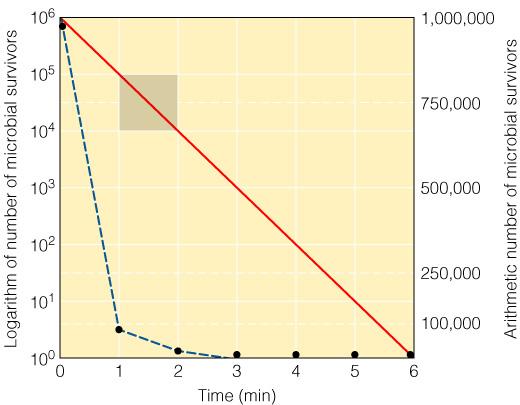 According to the figure, at what rate are the cells dying?
| back 143 90% each minute |
front 144 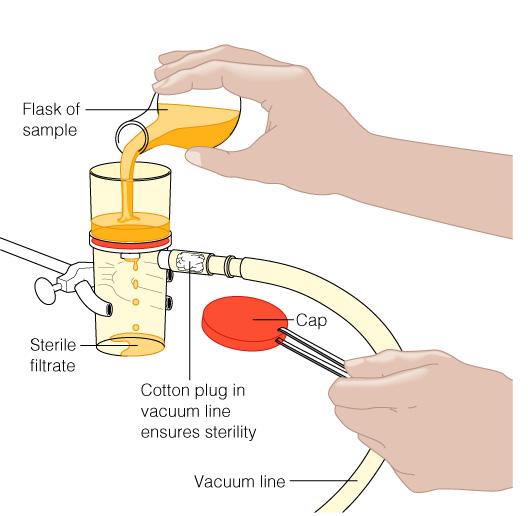 In the figure shown, what is the method of sterilization used?
| back 144 Filtration |
front 145 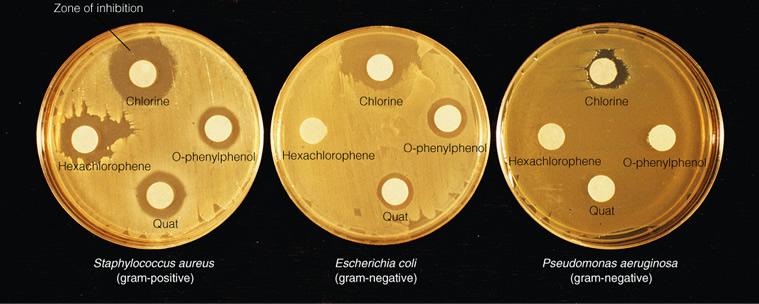 In the photo shown, it can be concluded that the quaternary ammonium compound (Quat) was most effective against:
| back 145 Staphylococcus aureus |
front 146 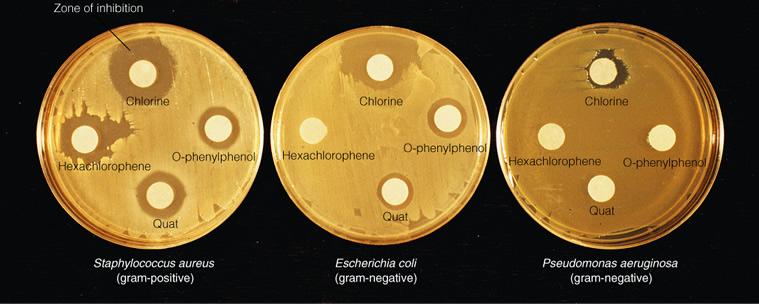 All of the following conclusions are correct regarding the photos of the disk-diffusion assay EXCEPT:
| back 146 Gram-negative bacteria are the most sensitive to the chemicals. |
front 147 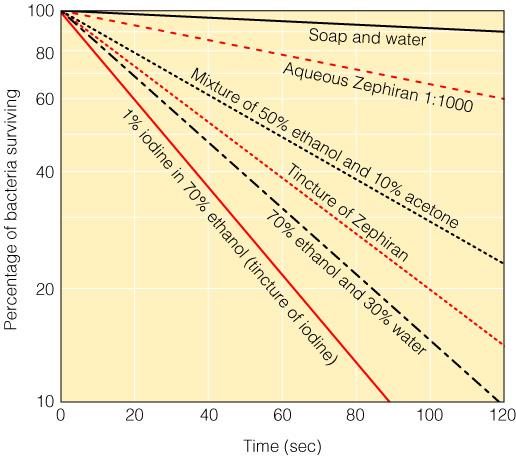 All of the following conclusions are correct regarding the graph shown EXCEPT:
| back 147 Aqueous Zephiran is more effective than the tincture of Zephiran. |
front 148 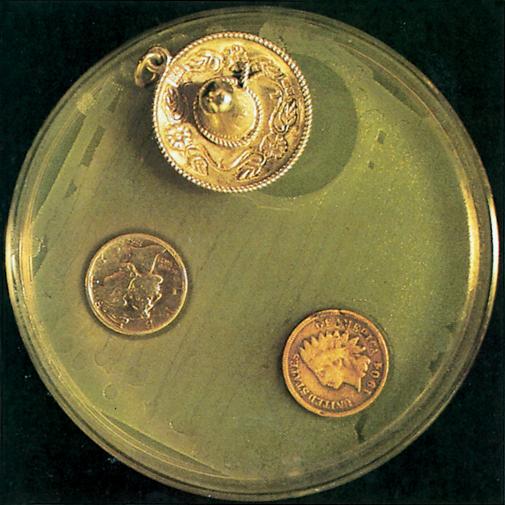 The clear zones around the coins on the plate in the photo are due which phenomenon?
| back 148 The oligodynamic action of the metals in the coins. |
front 149  Which chemical shown is a common ingredient in antibacterial soaps and at least one toothpaste?
| back 149 Triclosan |
front 150 You discover a compound that you suspect reduces spoilage in fruit. You treat apples with your compound and inoculate them with Botrytis, a common spoilage fungus. After seven days the dry weight of fungi on the treated apples is 5 mg and 10 mg on the untreated apples. You conclude from these results that:
| back 150 The compound is fungistatic. |
front 151 You contaminate kitchen counters with Salmonella enterica in chicken blood and expose it to a variety of treatments to study the survival of the bacteria on kitchen surfaces. The following DRT values were obtained: 2.0 min. at 52° C; 3.7 min. at pH 2.6; 13.3 min. with 10mM hydrogen peroxide; and >35 days without treatment. Which treatment is most effective against S. enterica?
| back 151 Heat. |
front 152 The best definition of sterilization is the:
| back 152 Removal of all microorganisms. |
front 153 What is the difference between a disinfectant and an antiseptic?
| back 153 Disinfectants are used on environmental surfaces; antiseptics are used on living tissue. |
front 154 Which of the following treatments achieves sterilization?
| back 154 Autoclaving. |
front 155 Which one of the following is not an antiseptic?
| back 155 Soap. |
front 156 Which one of the following kills cells by damaging DNA?
| back 156 Ultraviolet light. |
front 157 Which one of the following does not belong with the others?
| back 157 Chlorine. |
front 158 Which one of the following is not an antiseptic?
| back 158 Hydrogen peroxide. |
front 159 Which one of the following methods is bactericidal?
| back 159 None of these are bactericidal. |
front 160 Which one of the following is effective against bacterial endospores?
| back 160 Chlorine bleach. |
front 161 Which one of the following concentrations of ethyl alcohol is the most effective disinfectant?
| back 161 75% |
front 162 Four compounds are tested for their disinfectant activity. Compound A kills pseudomonads, mycobacteria, endospores, lipophilic viruses, and hydrophilic viruses. Compound B kills pseudomonads, mycobacteria, and lipophilic viruses. Compound C kills pseudomonads and lipophilic viruses. Compound D does not kill any of the test organisms. Which compound is most likely a soap?
| back 162 Compound D. |
front 163 Which of the following is not an oxidizing agent?
| back 163 Triclosan. |
front 164 Which one of the following is most useful for disinfecting medical instruments?
| back 164 Glutaraldehyde. |
front 165 Which one of the following is generally the easiest to kill?
| back 165 Lipophilic viruses. |
front 166 The use-dilution values for three disinfectants tested under the same conditions are: Disinfectant X- 1:10; Disinfectant Y-1:100; Disinfectant Z- 1:1,000. If the disinfectants are non-toxic and designed for the same purpose, which would you select?
| back 166 Z. |
front 167 The disk-diffusion test is used to test disinfectants against Staphylococcus aureus. For Disinfectant A, a 1:10 dilution gives a 25 mm zone of inhibition; 1:100 has a 15 mm zone of inhibition; and 1:1000 gives a 0 mm zone of inhibition. For Disinfectant B, a 1:10 dilution gives a 50 mm zone of inhibition; 1:100 has a 25 mm zone of inhibition; and 1:1000 gives a 10 mm zone of inhibition. Which disinfectant is most effective?
| back 167 B. |
front 168 The disk-diffusion test is used to test disinfectants against Staphylococcus aureus. For Disinfectant A, a 1:10 dilution gives a 25 mm zone of inhibition; 1:100 has a 15 mm zone of inhibition; and 1:1000 gives a 0 mm zone of inhibition. For Disinfectant B, 1:10 dilution gives a 50 mm zone of inhibition; 1:100 has a 25 mm zone of inhibition; and 1:1000 gives a 10 mm zone of inhibition. Which disinfectant is bactericidal?
| back 168 Cannot tell from the information given. |
front 169 You inoculate a nutrient agar plate with your fingers after washing your hands with water. Then you wash your hands with bar soap, rinse, and inoculate another nutrient agar plate. You repeat the handwashing with liquid soap and inoculate a third nutrient agar plate. The bar soap and liquid soap have the same chemical formulas. After incubating the plates, you record the amount of bacterial growth on a scale of - (no growth) to 3+ (maximum growth). Your results are: Water alone, +; Bar soap and water, 3+; Liquid soap and water, +. From these data, you can conclude that:
| back 169 Bacteria persist on bar soap. |